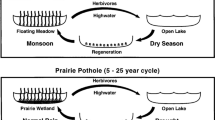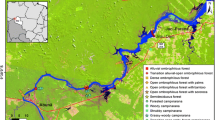Abstract
The transition from open water to a swamp forest of a complex of ponds in the ‘Polder Westbroek’ (The Netherlands) in the period 1937–1989 is studied. Changes between structurally different vegetation types are determined using remote-sensing data and a Geographical Information System. The transition follows a clear pathway from open water throughPhragmites/Typha-dominated community andCarex-dominated vegetation, toAlnus-dominated vegetation. The rate of this transition shows strong correspondence to changes in local management, demonstrating the large human impacts on ecosystems in this area.
Similar content being viewed by others
References
Beltman, B. & Rouwenhorst, G. 1991. Ecohydrology and fen plant distribution in the Vechtplassen area, The Netherlands. In: Nachtnebel, H.P. & Kovar, K. (eds), Hydrological basis of ecologically sound management of soil and groundwater. TAHS publ. 202: 199–204.
Beltman, B. & Rouwenhorst, G. 1993. Impact on soil fertility by replacement of hydrochemically different water types. In: Peters, N.E. (ed), Hydrological, chemical and biological processes affecting the transformation and transport of contaminants in aquatic invironment. IAHS publ. 205: 95–118.
Burrough, P.A. 1986. Principles of geographical information systems for land resources assessment. Clarendon Press, Oxford.
Colaris, W.J.J. 1979. Het Gooi en de Vechtstreek: Lusthof der Amsterdamse Heren. In: Brijns, M. & Frans, M. (eds), Spectrum atlas van de Nederlandse landschappen. pp. 38–54. Spectrum, Utrecht.
DenHeld, A.J., Schmitz, M. & VanWirdum, G. 1992. Types of terrestrializing fen vegetation in the Netherlands. In: Verhoeven, J.T.A. (ed), Fens and bogs in the Netherlands: Vegetation, history, nutrient dynamics and conservation. pp. 237–321. Kluwer Academic Publishers, Dordrecht.
Eysberg, C.D. 1981. Het Maarsseveense onland: herwaardering en ruimtelijk konflikt. Koninklijke Nederlands Aardrijkskundig Genootschap Geografisch Tijdschrift 14: 6–23.
Gleason, H. A. 1917. The structure and development of the plat association. Bulletin Torrey Botanical Club 43: 463–481.
Gore, A.J.P. (ed). 1983. Mires: swamp, bog, fen and moor. General studies, Vol. 4A. Elsevier Scientific Publishing Company, Amsterdam.
Gottschalk, M.K.E. 1956. De ontginning der Stichtse venen ten oosten van de Vecht. Koninklijke Nederlands Aardijkskundig Genootschap Geografisch Tijdschrift 83: 213–233.
Koerselman, W. 1989. Hydrology and nutrient budgets of fens in an agricultural landscape. Doctorate Thesis, Univ. Utrecht, Utrecht, The Netherlands.
Koerselman, W., Bakker, S.A. & Blom, M. 1990. Nitrogen, phosphorus and potassium mass balances for two small fens surrounded by pastures. Journal of Ecology 78: 428–442.
Luken, J.O. 1990. Directing ecological succession. Chapman and Hall, London.
Succow, M. 1988. Landschaftsökologische Moorkunde. G. Fisher Verlag, Jena.
Van Wirdum, G. 1982. The ecohydrological approach to nature protection. RIN Leersum, Annual Report: 60–74.
VanWirdum, G., DenHeld, A.J. & Schmitz, M. 1992. Terrestrializing fen vegetation in former turbaries in the Netherlands. In: Verhoeven, J.T.A. (ed), Fens and bogs in the Netherlands: Vegetation, history, nutrient dynamics and conservation. pp. 323–360. Kluwer Academic Publishers, Dordrecht.
Verhoeven, J.T.A. 1986. Nutrient dynamics in minerotrophic peat mires. Aquatic Botany 25: 117–138.
Verry, E.S. & Boelter, D.H. 1978. Peatland hydrology. In: Greeson (ed), Wetland functions and values: the state of our understanding. pp. 389–402. American Water Resources Association.
Westhoff, V. & DenHeld, A.J. 1969. Plantengemeenschappen in Nederland. Thieme, Zutphen.
Wiegers, J. 1992. Carr vegetation: plant communities and succession of dominant tree species. In: Verhoeven, J.T.A. (ed), Fens and bogs in the Netherlands: Vegetation, history, nutrient dynamics and conservation. pp. 237–321. Kluwer Academic Publishers, Dordrecht.
Author information
Authors and Affiliations
Rights and permissions
About this article
Cite this article
Bakker, S.A., van den Berg, N.J. & Speleers, B.P. Vegetation transitions of floating wetlands in a complex of turbaries between 1937 and 1989 as determined from aerial photographs with GIS. Vegetatio 114, 161–167 (1994). https://doi.org/10.1007/BF00048395
Accepted:
Issue Date:
DOI: https://doi.org/10.1007/BF00048395




